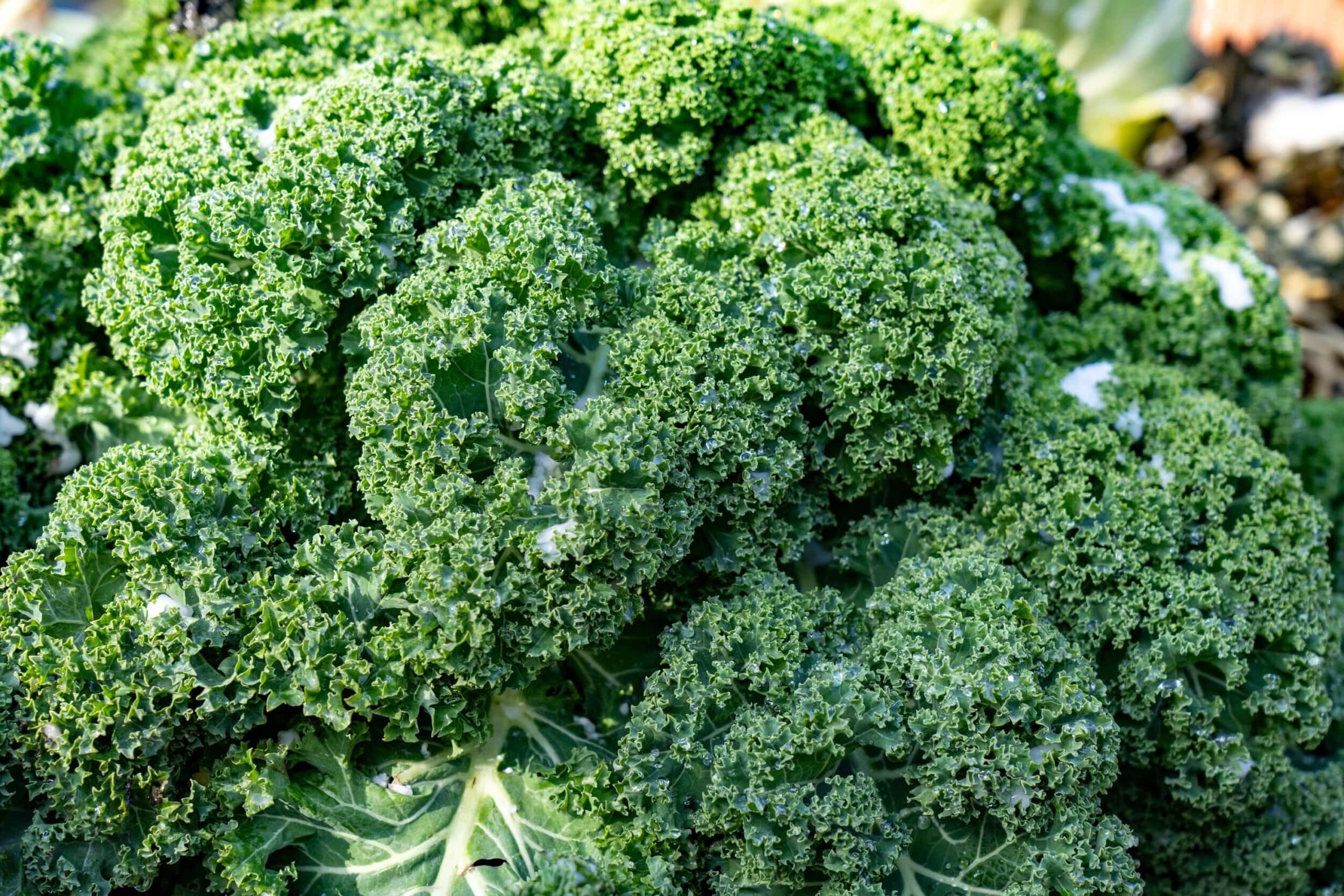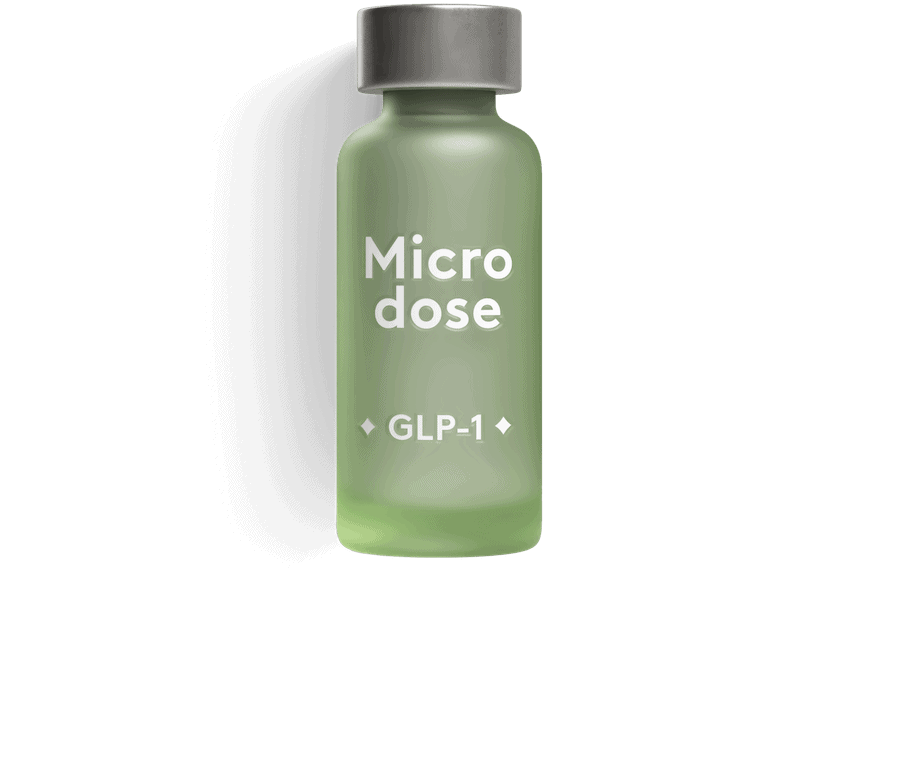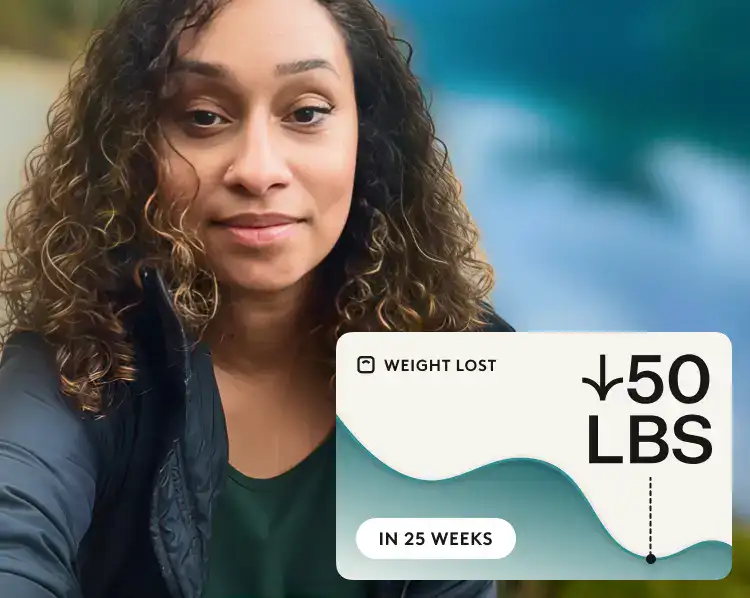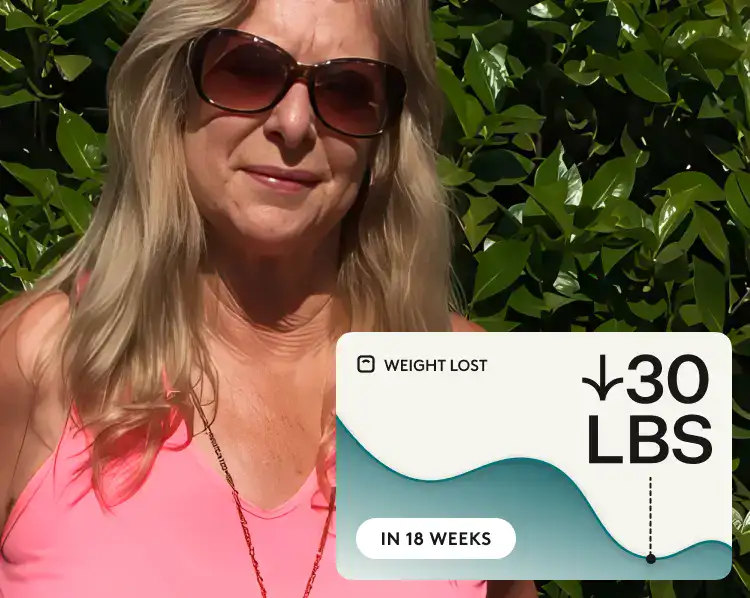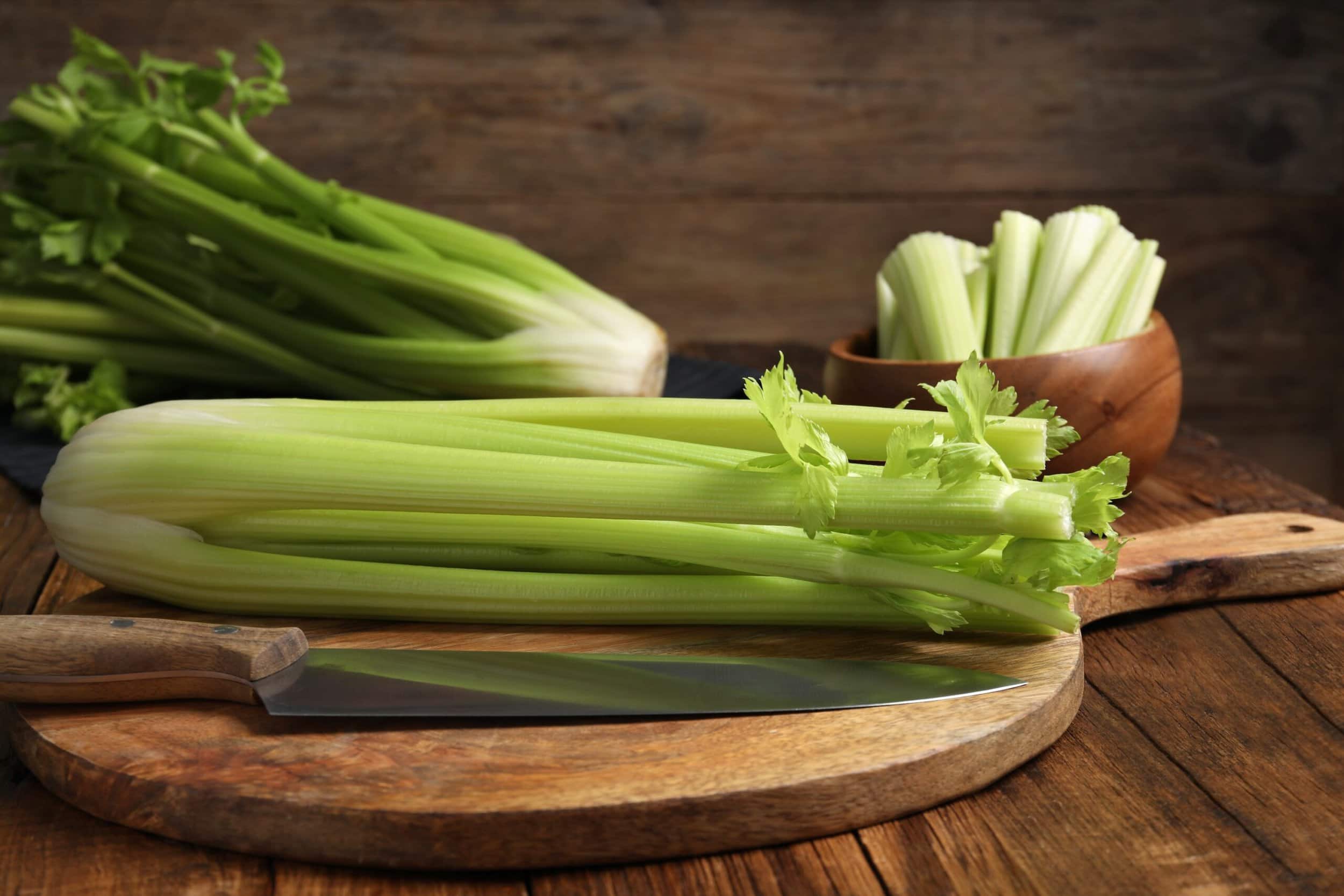Kale didn’t become a wellness staple by accident. This leafy green really does earn its reputation: it’s naturally low in calories, high in nutrients, and works in everything from smoothies to sheet-pan dinners. What makes kale especially helpful for weight loss is its high in fiber. You can eat a generous, satisfying portion and the fiber helps you stay fuller longer.
On top of that, kale brings key nutrients like vitamin K (for bone health), vitamin A (for skin and immune support), and a range of antioxidants that help the body manage inflammation. And it’s easy to work with. Blend it, sauté it, bake it into chips, or massage it into a salad—kale is flexible enough to fit your routine rather than the other way around.
Let’s take a closer look at how this powerhouse green supports your health and helps keep hunger in check.
✅ Quick answer
Yes, kale is an excellent food for weight loss. Kale helps you feel full and satisfied without adding many calories to your day.
🚀 Weight‑loss benefits
- It’s extremely low in calories – You can eat a lot of kale for very few calories. One cup of chopped kale is only about 16 calories, so you can add a generous portion to meals without feeling like you’re “spending” much of your daily calorie budget. That’s the power of low energy density: you get fuller plates and fewer feelings of restriction.
- It’s high in fiber – Kale contains nearly 1 gram of fiber per cup, which helps slow digestion and keeps you satisfied longer. When meals feel more filling, it becomes easier to avoid grazing between meals and stay on track with your goals.
- It’s packed with nutrients – When you’re cutting calories, every bite needs to count. Kale delivers vitamins A, C, and K, plus minerals like calcium and manganese, to help support energy, immunity, and metabolism. In other words, it helps your body feel nourished—even when you’re intentionally eating a little less.
⚠️ Things to be mindful of
- It’s very high in vitamin K – One cup of kale provides more than double your daily vitamin K needs, which is great for bone health. But if you take a blood thinner like warfarin, you’ll want to keep your kale intake consistent day to day. Sudden changes (like going from no kale to daily kale salads) can affect how your medication works, so it’s a good idea to check in with your doctor if this applies to you.
- Kale contains goitrogens (but context matters) – Like other cruciferous veggies, kale has naturally occurring compounds that can interfere with thyroid function. This is usually only and issue if they’re eaten in very large amounts, especially raw. For most people, regular portions are totally fine. If you already have a thyroid condition, just be mindful of how much you eat and consider enjoying kale cooked, which reduces these compounds.
- It may cause digestive discomfort at first – Kale’s fiber can keep you full, but it can also lead to bloating or gas if your body isn’t used to it. If you’re new to eating a lot of greens, start with smaller servings and increase gradually. Pairing kale with water throughout the day helps your digestive system adjust more comfortably.
Rx weight loss, the right way, with Noom
Get access to prescription weight loss medication with Noom.🥗 Nutrients in kale (per 1 cup chopped, about 47g)
| Nutrient | Amount | % RDA* |
|---|---|---|
| Calories | 16 calories | 1% |
| Protein | 1.4 g | 3% |
| Total carbs | 2.1 g | 1% |
| Fiber | 0.9 g | 3% |
| Sugars | 0.5 g | — |
| Total fat | 0.7 g | 1% |
| – Saturated fat | 0.1 g | 1% |
| – Monounsaturated fat | 0.05 g | — |
| – Polyunsaturated fat | 0.2 g | — |
| Omega-3 | 56 mg | — |
| Omega-6 | 63 mg | — |
At just 16 calories per cup, kale is one of the lowest-calorie foods you can put on your plate. That means you can add a generous amount to meals to boost fullness and nutrition without really moving the needle on your daily calorie intake. Most of its carbohydrates come from fiber rather than sugar, which helps support steady energy and reduces the spikes and dips that can lead to cravings.
Kale isn’t a major protein source, but it does offer a little along with small amounts of healthy fats, including omega-3s. The real standout is its nutrient-to-calorie ratio: you’re getting a high concentration of vitamins and minerals for almost no caloric “cost.” When you’re aiming for sustainable weight loss, foods like kale make it easier to feel well-nourished and satisfied while maintaining your calorie goals.
*Recommended dietary allowance (RDA) is defined as the average daily amount of nutrients needed to meet the requirements of nearly all healthy people in a specific group.
💊 Vitamins & minerals in kale (per 1 cup chopped, about 47g)
| Vitamin/Mineral | Amount | % RDA* |
|---|---|---|
| Vitamin K | 183.3 μg | 153% |
| Vitamin C | 43.9 mg | 49% |
| Vitamin A | 113.4 μg | 13% |
| Manganese | 0.4 mg | 18% |
| Calcium | 119.4 mg | 9% |
| Folate (B9) | 29.2 μg | 8% |
| Copper | 0.1 mg | 10% |
| Iron | 0.8 mg | 4% |
| Magnesium | 15.5 mg | 4% |
| Potassium | 163.6 mg | 3% |
Kale’s vitamin and mineral lineup is pretty remarkable. Just one cup delivers well over your daily needs for vitamin K, which supports bone health and healthy blood clotting. It also provides nearly half of your vitamin C for the day, giving your immune system a boost and helping your body absorb iron more effectively—especially helpful if you lean on plant-based sources.
You’ll also get vitamin A (in the form of beta-carotene) for vision and immune function, plus manganese, which plays a role in bone formation and metabolism. And unlike spinach, the calcium in kale is more readily absorbed, making it a great option for anyone who doesn’t eat much dairy. So kale isn’t just adding bulk to your meals—it’s actively supporting your body while you’re working toward weight loss.
🔍 Nutrient breakdown
Glycemic index (GI) of kale
✔️ Glycemic index: <15 (Low)
💡 Tip: Low-GI foods like kale are digested slowly, which means they don’t cause sharp spikes in your blood sugar or insulin levels. This helps control hunger, reduces cravings, and creates a less favorable environment for fat storage.
Is kale high in protein?
❌ No: Kale contains 1.4 g of protein per cup. While this is decent for a leafy green, it’s not considered a high-protein food. The protein contributes to satiety and provides some essential amino acids, but you’ll need to pair kale with other protein sources to meet your daily needs.
🔹 Better protein alternatives: Grilled chicken | Greek yogurt | Lentils
Is kale high in fiber?
✔️ Yes: Kale provides 0.9 g of fiber per cup, which is excellent considering how low in calories it is. This fiber adds bulk to your meals, slows stomach emptying, and promotes feelings of fullness that can last for hours.
💡 Tip: Pair high-fiber foods like kale with plenty of water throughout the day to aid digestion and maximize the filling effect.
Is kale low in carbs?
✔️ Yes: Kale has just 2.1 g of total carbs per cup, with nearly half of that coming from fiber. This gives it a very low net carb count of about 1.2 g, making it ideal for low-carb and ketogenic diets while having minimal impact on blood sugar.
💡 Tip: For a satisfying low-carb meal, use kale as a base for salads topped with a protein source and healthy fats like avocado or olive oil dressing.
Is kale gluten-free?
✔️ Yes: Kale is a vegetable and is naturally 100% gluten-free. It’s a safe and nutritious choice for people with celiac disease or non-celiac gluten sensitivity. Just make sure any dressings or toppings you add are also certified gluten-free.
Is kale good for fat loss?
✔️ Yes: Thanks to its low-calorie, high-fiber profile, kale is extremely helpful for fat loss. It helps create the calorie deficit needed to lose weight by promoting fullness and reducing overall food intake. Its rich nutrient content also supports healthy metabolic function, which is essential for efficient fat burning.
💡 Tip: Add kale to your meals to increase volume and nutrients without adding significant calories, helping you stay satisfied while your body burns stored fat.
🍽️ Diet compatibility: Which diets include kale?
| Diet | ✅ Yes / ❌ No | Why it works |
|---|---|---|
| Keto | ✅ | With about 1.2 g of net carbs per cup, kale adds fiber and micronutrients without pushing you past your daily carb limit. |
| Paleo | ✅ | It’s a whole, unprocessed plant food, which fits right into the Paleo emphasis on natural, nutrient-dense ingredients. |
| Mediterranean | ✅ | Vegetables are the foundation of Mediterranean-style eating, and kale brings heart-healthy nutrients and antioxidants to the mix. |
| Vegan | ✅ | Kale is fully plant-based and supplies nutrients vegans benefit from, like calcium and iron. |
| Gluten-free | ✅ | Naturally gluten-free, kale works for anyone avoiding gluten due to celiac disease or sensitivity. |
Kale’s versatility is one of its biggest strengths. It’s low in calories, low in net carbs, and completely unprocessed, which means it fits seamlessly into almost any way of eating—from structured diets to simple “eat more plants” goals. However you build your meals, kale tends to play well with the other ingredients on your plate.
🌟 Is kale healthy? What are the health benefits
Metabolic health: Is kale good for your metabolism?
- ❌ Boosts metabolism? No – Kale doesn’t directly speed up your metabolic rate in a measurable way. However, its rich supply of B vitamins and minerals like magnesium and manganese supports the biochemical pathways your body uses to produce energy. A well-nourished body is better equipped to maintain an efficient metabolism.
- ✔️ Improves insulin sensitivity? Yes – The fiber in kale slows the absorption of sugar into your bloodstream, which helps prevent insulin spikes. Some research also suggests that antioxidants like alpha-lipoic acid found in kale may improve insulin sensitivity over time, though more research is needed.
- ✔️ Effect on fat storage? Helps prevent – By promoting satiety and helping stabilize blood sugar and insulin levels, kale creates an internal environment that’s less conducive to fat storage. Its extremely low calorie count makes it easy to maintain the calorie deficit that drives fat loss.
Cholesterol impact: Does kale affect cholesterol levels?
- ✔️ Does it lower LDL (bad) cholesterol? Yes – Kale contains compounds that can bind to bile acids in your digestive system, preventing them from being reabsorbed. This forces your body to use existing cholesterol to produce new bile acids, which can lead to a reduction in LDL cholesterol levels. Lightly steaming kale may actually enhance this cholesterol-lowering effect.
- ❌ Does it raise HDL (good) cholesterol? No – There’s limited evidence that kale directly raises HDL cholesterol. However, by improving your overall diet quality and supporting healthy weight loss, incorporating kale can contribute to a better overall cholesterol profile.
- ✔️ Overall impact on heart health? By helping lower LDL cholesterol, providing potassium for blood pressure regulation, and delivering anti-inflammatory antioxidants, kale offers multiple cardiovascular benefits. Regular consumption as part of a balanced diet supports long-term heart health.
💡 Tip: Drizzle your kale salad with extra virgin olive oil, which provides monounsaturated fats that further support healthy cholesterol levels.
Can I eat kale for a calorie deficit?
✔️ Yes, with confidence: Kale is one of the best foods for maintaining a calorie deficit. Its high volume and low-calorie nature mean you can eat large, satisfying portions without consuming many calories. This helps combat hunger, which is often the biggest challenge when trying to lose weight.
💡 Tip: Start your main meals with a large kale salad to reduce hunger and naturally decrease your calorie intake during the rest of the meal.
Is kale rich in antioxidants?
✔️ Yes: Kale is loaded with powerful antioxidants, including beta-carotene, vitamin C, and various flavonoids and polyphenols. Two particularly notable flavonoids—quercetin and kaempferol—have been shown in studies to have anti-inflammatory, heart-protective, and antiviral effects.
💡 Tip: Combine kale with other antioxidant-rich foods like berries in a smoothie to maximize your intake of these protective compounds.
Does kale support gut health?
✔️ Yes: The insoluble fiber in kale adds bulk to your stool, promoting regularity and preventing constipation. This fiber also acts as a prebiotic, providing food for the beneficial bacteria in your gut microbiome, which is crucial for digestive health, immune function, and even mood regulation.
Does kale support digestion?
✔️ Positive: A healthy gut microbiome, supported by fiber from foods like kale, plays a key role in efficient digestion and nutrient absorption. Kale’s high water content also helps keep your digestive system moving smoothly.
⚠️ Note for sensitive stomachs: For some people, especially those not accustomed to high-fiber diets, kale can cause gas and bloating. This is partly due to a sugar called raffinose that humans can’t easily digest. Cooking kale can help make it gentler on your system.
💡 Tip: If you’re sensitive, start with small, cooked portions of kale and gradually increase your intake as your digestive system adapts.
Does kale help you feel satiated and less hungry?
✔️ High: The combination of fiber and high water content makes kale exceptionally filling relative to its calorie content. It takes up significant space in your stomach, sending fullness signals to your brain that can last for several hours, helping prevent snacking between meals.
🍽️ Satiety Level: High
💡 Tip: To maximize satiety, pair kale with a source of protein and healthy fats, such as adding grilled chicken, chickpeas, and avocado to your kale salad.
Does kale help with nighttime cravings?
✔️ Yes: Eating a balanced, fiber-rich dinner that includes kale can help prevent the blood sugar crashes that often trigger evening cravings. This stable energy level reduces the likelihood of reaching for high-calorie, sugary snacks before bed.
💡 Tip: If you struggle with nighttime hunger, try having a larger dinner salad with kale as the base, topped with lean protein and healthy fats to keep you satisfied through the evening.
Does kale help reduce inflammation?
✔️ Yes: Kale contains numerous anti-inflammatory compounds, including antioxidants and a favorable ratio of omega-3 to omega-6 fatty acids. Chronic inflammation is linked to many diseases, including obesity, and a diet rich in anti-inflammatory foods like kale can help reduce this risk.
Is kale beneficial for brain health?
✔️ Yes: Nutrients abundant in kale, such as vitamin K, lutein, beta-carotene, and folate, are linked to better cognitive health. Some studies suggest these nutrients may help slow age-related cognitive decline and support memory and learning.
Can kale improve skin and hair health?
✔️ Yes: The high levels of vitamin C in kale are essential for collagen production, which gives skin its structure and elasticity. Vitamin A is crucial for the growth and repair of all body tissues, including skin and hair. The antioxidants also help protect against oxidative stress that can age skin prematurely.
Can kale help balance hormones?
⚠️ Limited evidence: While kale doesn’t directly regulate hormones, its nutrients support overall health, which is important for a balanced endocrine system. However, the goitrogenic compounds in raw kale may impact thyroid hormone production in people with existing thyroid conditions, so moderation is key for those individuals.
💡 Tip: For broader hormonal health, focus on a balanced diet rich in a variety of vegetables, adequate protein, healthy fats, and stress management rather than relying on any single food.
🍽️ Best ways to eat kale for weight loss
- Raw in salads and smoothies – Eating kale raw keeps its vitamin C content intact and works well in salads and smoothies. If you choose raw kale, especially regularly, just remember our earlier note: very large amounts of raw kale can affect thyroid function in people who already have thyroid concerns. For most people, though, raw kale in normal portions is perfectly fine. To make it tastier, massage the leaves with a little olive oil and lemon juice to soften the texture and mellow the bitterness.
- Lightly steamed or sautéed – Light cooking can make kale easier to digest and may support its cholesterol-lowering properties. Sautéing with garlic and a small drizzle of olive oil or steaming until just tender keeps calories low while helping your body absorb more of the nutrients. This is also a great option if you have a thyroid condition and want to reduce goitrogens.
- Avoid deep-frying or heavy creams – Deep-fried kale chips can quickly turn a naturally low-calorie food into something calorie-dense. If weight loss is your goal, try seasoning over-baked chips with citrus, herbs, vinegar, or a sprinkle of parmesan.
🍏 Best alternatives & comparisons (Per 1 cup chopped, raw)
| Food | Calories | Carbs | Fiber | Protein | Fat |
|---|---|---|---|---|---|
| Kale | 16 | 2.1 g | 0.9 g | 1.4 g | 0.7 g |
| Spinach | 7 | 1.1 g | 0.7 g | 0.9 g | 0.1 g |
| Swiss chard | 7 | 1.4 g | 0.6 g | 0.6 g | 0.1 g |
| Collard greens | 12 | 1.9 g | 1.5 g | 1.1 g | 0.2 g |
| Romaine lettuce | 8 | 1.5 g | 1.0 g | 0.6 g | 0.1 g |
| Arugula | 5 | 0.7 g | 0.3 g | 0.5 g | 0.1 g |
Kale stands out among leafy greens because it brings a bit of everything: solid fiber, a little protein, and a high concentration of vitamins and minerals. While spinach and Swiss chard are lower in calories, kale offers more fiber per cup, which can help meals feel more filling and satisfying. Collard greens come closest to kale’s profile and can be an easy swap if you want a different flavor or texture.
Romaine and arugula are refreshing, hydrating options with a lighter nutrient load. They’re great for building volume into meals, but they’re not quite as filling as kale or collards.
Variety is your best friend. Rotating between kale, spinach, collards, chard, and other greens ensures you’re getting a wide range of nutrients while keeping meals interesting. Kale may be the nutrient star, but a mix of greens supports long-term health and makes eating well feel more flexible—not restrictive.
Frequently asked questions about kale and weight loss
Can I eat kale every day for weight loss?
Yes, you can eat kale daily as part of a balanced weight loss diet. Its low-calorie and high-nutrient content make it an excellent everyday food. However, if you have thyroid issues, it’s wise to vary your greens and consult with your healthcare provider about appropriate portions. For most people, 1-2 cups per day is perfectly healthy.
Is raw or cooked kale better for weight loss?
Both are great for weight loss since cooking doesn’t significantly change the calorie content. Raw kale retains more vitamin C, while lightly cooked kale is easier to digest and may have enhanced cholesterol-lowering benefits. Choose based on your preference and how your digestive system responds. If raw kale causes bloating, cooking it may help.
Does kale burn belly fat?
No single food can specifically target belly fat. However, kale supports overall fat loss by helping you maintain a calorie deficit. Its high fiber content promotes fullness while its low calorie density allows you to eat satisfying portions. Combined with a balanced diet and regular activity, kale can be part of an effective fat loss strategy.
How much kale should I eat per day for weight loss?
There’s no magic amount, but 1-2 cups of raw kale daily (or ½-1 cup cooked) is a reasonable target that provides substantial nutrients without overdoing it. The key is incorporating kale as part of a varied diet rich in different vegetables, proteins, and healthy fats rather than relying on any single food.
Can kale make you gain weight?
Kale itself won’t cause weight gain due to its extremely low calorie content. However, if you prepare it with high-calorie additions like excessive oil, creamy dressings, cheese, or bacon, those extras can add up quickly. Stick to lighter preparations like steaming, light sautéing, or using measured amounts of healthy dressings.
Will eating kale help me lose weight faster?
Kale can support faster weight loss by helping you feel full on fewer calories, making it easier to maintain a calorie deficit. However, sustainable weight loss depends on your overall eating pattern, not just one food. Think of kale as a valuable tool in your weight loss toolkit rather than a magic solution.
Can I replace meals with kale?
While kale is incredibly nutritious, it shouldn’t be your only food. It lacks sufficient protein and healthy fats to constitute a complete meal on its own. Instead, use kale as a substantial component of balanced meals that also include lean proteins, healthy fats, and other vegetables for optimal nutrition and satiety.
🧠 The bottom line: Kale is excellent for weight loss
Kale really does earn its reputation when it comes to weight loss. With just 16 calories per cup and nearly a gram of fiber, it gives you a lot of fullness for very little calorie “spend.” That means you can create a calorie deficit without feeling deprived. And because it’s packed with vitamins and minerals, you’re still giving your body what it needs to support energy, metabolism, and overall health even when you’re eating a little less.
In day-to-day meals, kale works because it’s versatile. It blends into smoothies, forms the base of hearty salads, and sautés into a simple side dish. It also fits into almost every eating style—from keto to vegan to Mediterranean. As we mentioned earlier, just keep portions consistent if you’re on blood thinners, and ease in gradually if you’re not used to high-fiber foods.
The goal isn’t to treat kale like a “diet food,” but to use it as a nutrient-dense building block that helps meals feel satisfying and nourishing at the same time. Pair it with lean proteins, healthy fats, and flavors you enjoy, and kale becomes less of a trend and more of a practical tool that supports weight loss in a way that feels sustainable.
📖 Scientific evidence
- Cruciferous vegetables may support heart health (The American Journal of Clinical Nutrition, 2021). A large long-term study found that people who ate more cruciferous vegetables—like kale, broccoli, and cabbage—had a lower risk of both overall mortality and cardiovascular-related mortality over time.
- Kale is rich in beneficial plant compounds (Molecules, 2025). A review found that kale contains powerful antioxidants and phytochemicals that may help reduce inflammation, support heart health, and promote healthier cholesterol levels.
- Cruciferous vegetables may support longevity (Clinical Nutrition, 2019). In a large long-term study, people who ate more cruciferous vegetables—like kale, broccoli, and cabbage—had a noticeably lower risk of dying from any cause over nearly 17 years of follow-up. The highest-intake group saw about a 10–15% lower risk compared to those who ate very little.
- Dietary compounds in cruciferous veggies may protect against chronic disease (Frontiers in Pharmacology, 2021). A review found that phytochemicals called glucosinolates (found in greens like kale, broccoli, and cabbage) appear to work through anti-inflammatory and antioxidant pathways, supporting heart, metabolic, neurological, and bone health.
- Cruciferous vegetables may help lower blood pressure (BMC Medicine, 2024). In a small study, people with slightly high blood pressure ate more cruciferous vegetables—like kale, broccoli, and cabbage—for two weeks. During that time, their blood pressure dropped by a few points compared to when they ate other types of vegetables. This is a small change, but even small drops in blood pressure can help support heart health over time.
Why you can trust us
At Noom, we’re committed to providing health information that’s grounded in reliable science and expert review. Our content is created with the support of qualified professionals and based on well-established research from trusted medical and scientific organizations. Learn more about the experts behind our content on our Health Expert Team page.

